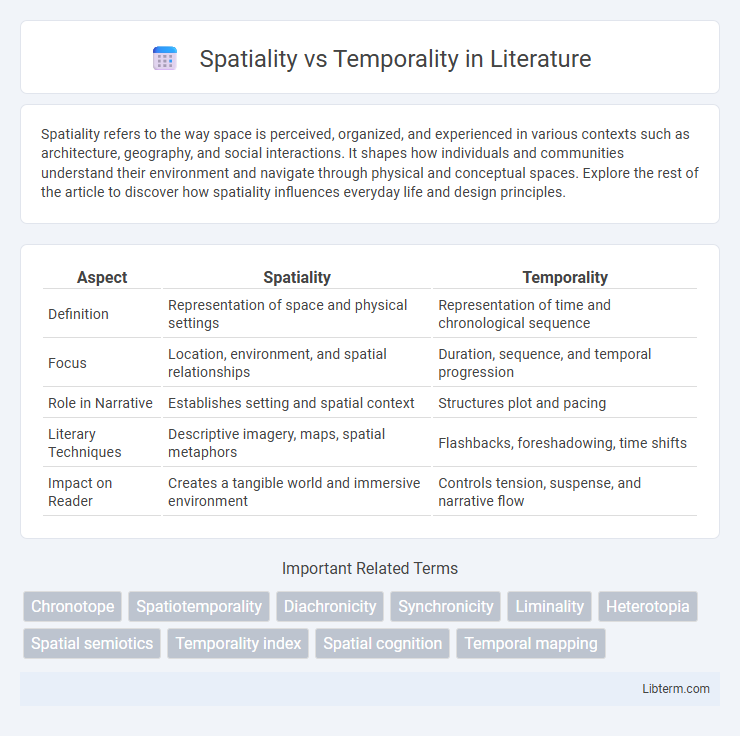Spatiality refers to the way space is perceived, organized, and experienced in various contexts such as architecture, geography, and social interactions. It shapes how individuals and communities understand their environment and navigate through physical and conceptual spaces. Explore the rest of the article to discover how spatiality influences everyday life and design principles.
Table of Comparison
| Aspect | Spatiality | Temporality |
|---|---|---|
| Definition | Representation of space and physical settings | Representation of time and chronological sequence |
| Focus | Location, environment, and spatial relationships | Duration, sequence, and temporal progression |
| Role in Narrative | Establishes setting and spatial context | Structures plot and pacing |
| Literary Techniques | Descriptive imagery, maps, spatial metaphors | Flashbacks, foreshadowing, time shifts |
| Impact on Reader | Creates a tangible world and immersive environment | Controls tension, suspense, and narrative flow |
Defining Spatiality and Temporality
Spatiality refers to the characteristics and properties that define the physical space and its dimensions, emphasizing location, distance, and spatial relationships between objects or environments. Temporality involves the conceptualization of time, focusing on the sequencing, duration, and temporal order in which events occur or phenomena change. Defining spatiality and temporality allows for the analysis of how space and time shape human experience and interactions within various contexts.
Historical Perspectives on Space and Time
Historical perspectives on space emphasize the physical and measurable dimensions shaping human experience, while temporality centers on the fluid and subjective nature of time as experienced and interpreted across cultures. Philosophers like Henri Bergson highlighted temporal duration as a qualitative experience contrasting with spatial metrics, influencing modern understandings of history and memory. The interplay between spatiality and temporality in historical analysis reveals how societies construct and perceive chronological events within physical environments, shaping identity and cultural narratives.
Philosophical Foundations of Spatiality
Spatiality in philosophy originates from ancient metaphysical inquiries into the nature of space as an independent entity or relational construct, emphasizing its role in defining the existence and arrangement of objects. Philosophers like Immanuel Kant argued that space is an a priori intuition shaping human perception, while phenomenologists such as Edmund Husserl and Maurice Merleau-Ponty explored spatiality as integral to lived experience and embodiment. This foundational debate situates spatiality as a critical concept for understanding reality's structure, distinct from temporality, which addresses the sequential and changing dimensions of existence.
Temporal Dimensions in Human Experience
Temporal dimensions shape human experience by structuring perceptions of past, present, and future, influencing cognition and decision-making processes. The subjective experience of time affects memory formation, anticipation, and emotional responses, anchoring personal identity within a continuous temporal flow. Understanding temporality enhances insights into psychological states and social interactions, emphasizing time's critical role in human consciousness and behavior.
Intersections: When Space Meets Time
Spatiality and temporality intersect to create a multidimensional understanding of experience, where physical locations interact dynamically with temporal sequences. This intersection reveals how spatial contexts influence the perception of time, as seen in urban planning where the layout of a city regulates daily rhythms and social interactions. The study of spatiotemporal intersections enhances disciplines like geography, architecture, and cognitive science by elucidating how environments and temporal processes coalesce to shape human behavior and cultural practices.
Spatiality in Art and Architecture
Spatiality in art and architecture emphasizes the manipulation and organization of physical space to create immersive and dynamic experiences. It involves the deliberate arrangement of forms, volumes, and voids to influence perception, movement, and interaction within an environment. Prominent examples include the open floor plans of modernist architecture and the spatial layering found in abstract art, which challenge traditional boundaries and redefine the relationship between the observer and the space.
Temporality in Literature and Narrative
Temporality in literature shapes narrative structure through the manipulation of time, including flashbacks, foreshadowing, and nonlinear storytelling, enriching plot complexity and thematic depth. Narrative temporality influences character development and reader engagement by controlling the pacing and sequencing of events to reflect psychological or cultural perceptions of time. Literary works utilize temporal shifts to explore memory, history, and temporal consciousness, making temporality a central element in narrative meaning and interpretation.
Cognitive Approaches to Space and Time
Cognitive approaches to space and time emphasize the mental representations and neural mechanisms underlying spatial and temporal perception. Spatiality involves how the brain encodes and interprets spatial relationships and environments, often engaging regions like the hippocampus and parietal cortex. Temporality focuses on the perception and organization of time intervals and sequences, relying on cognitive processes including working memory and attention networks to integrate temporal information.
Implications for Technology and Digital Spaces
Spatiality in technology emphasizes the physical arrangement and proximity of digital elements, influencing user interface design and immersive experiences, while temporality focuses on timing, duration, and sequencing affecting real-time data processing and asynchronous communication. Digital spaces leverage spatiality to create intuitive navigation and virtual environments, whereas temporality drives synchronization in multimedia streaming, collaboration tools, and time-sensitive interactions. Understanding the interplay of spatiality and temporality enhances the development of responsive, context-aware technologies that adapt to user behavior and environmental dynamics.
Future Directions: Rethinking Space and Time
Future directions in rethinking space and time emphasize integrating spatiality and temporality through advanced technologies like GIS and real-time data analytics to capture dynamic, multidimensional environments. Emerging research explores temporal layers within spatial frameworks, enabling more precise modeling of evolving urban and natural landscapes. This approach fosters innovative applications in smart cities, climate change adaptation, and augmented reality, reshaping how space and time intersect in practical and theoretical contexts.
Spatiality Infographic

 libterm.com
libterm.com